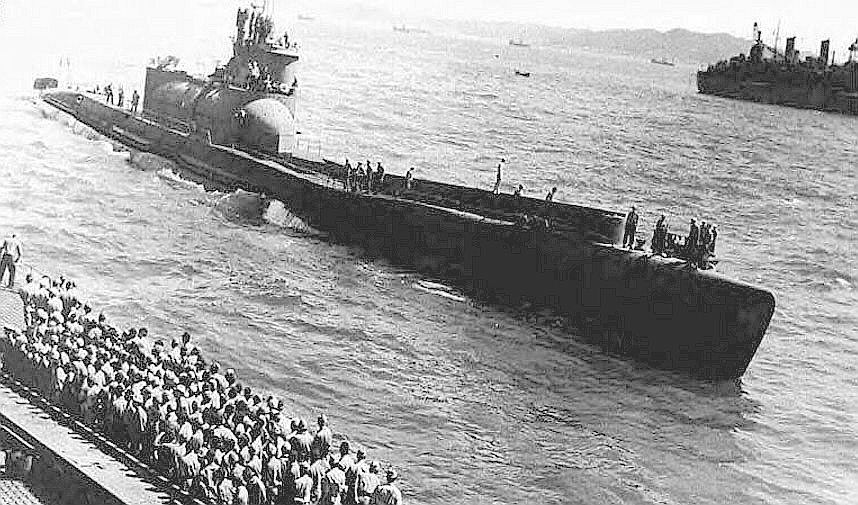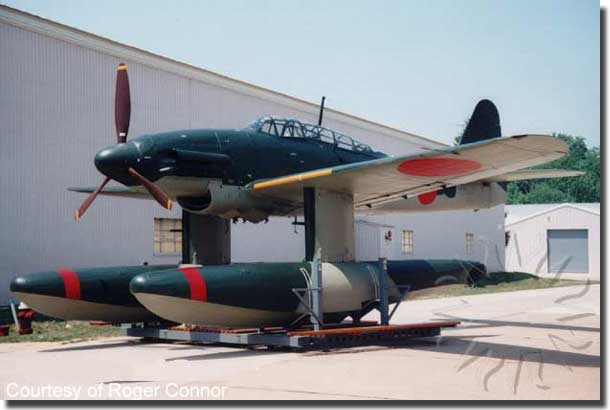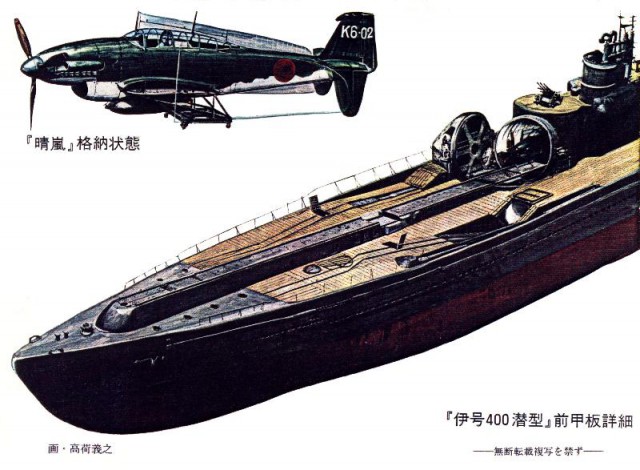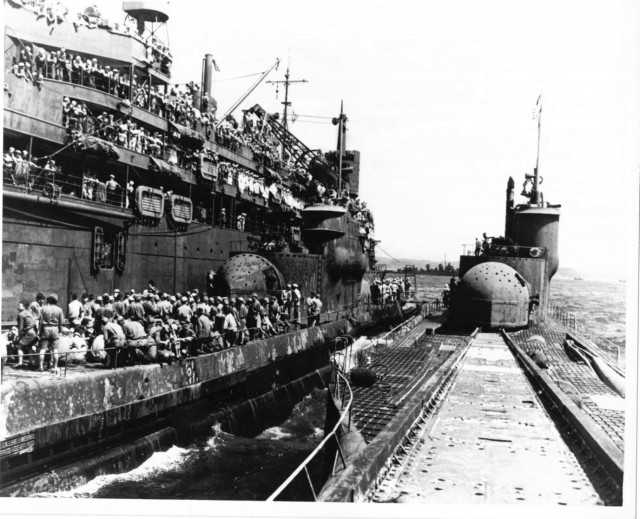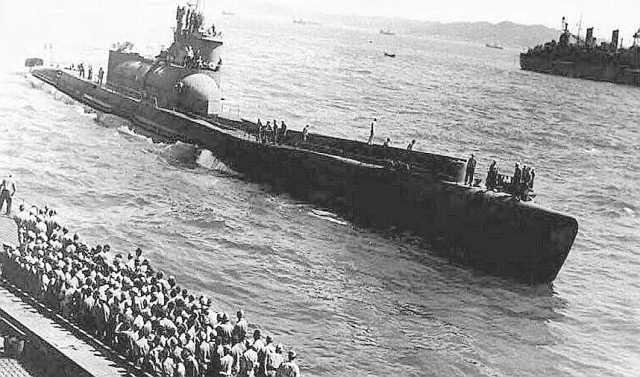
Japanese Navy under the visionary Adm. Yamamoto (architect of the Pearl Harbor Assault in Dec 41) developed a plan for a fleet of huge Subs that each carried 3 Hi-Tech attack/ bombers inside a tubular hangar, that was mounted on a double-tubed fuselage. The novel design gave stability with 2 hulls welded next to each other and made up for the largest Submarine ever built until the 1960’s nuclear subs came out.
Overall length was 400 whopping feet (122 m) and an unrivaled armament of a huge 140 mm canon (never seen before on a sub) plus 4 power packs with AA guns and special torpedo’s inside, But the real surprise was on top of the double hull, a spectacular hangar with inside 3 Aichi-M6 Seiran aircraft that could each carry a 1850 lbs. bomb over a 1000 miles. From a long launch ramp on the front deck of the sub, a steam catapult was used to get the aircraft airborne and after landing on their floats, a foldable crane was used to hoist the aircraft back on board.
The original order of 18 such I-400 series subs was slashed to 9 after Admiral Yamamoto got killed by a US Interception force on the way to the Solomon Islands. With the inspirational mind of the Master gone, the Monster Sub program soon started to lag behind the fast developments in the Pacific War and a tragic career of missed opportunities followed for what were potentially the most lethal weapons the Japanese had to threaten the dominant US Navy. In Dec 1944 the first of the series, I-400 was commissioned, soon followed by I-401. Their original plan to terrorize the US West Coast cities failed as the impact of only 2 subs with 6 planes would not be sufficient to make any impact, This plan was not fully abandoned, instead the Japanese developed a similar plan but with use of Biological weapons to attack large cities and spread bacterial diseases, as they had developed in China since the late 1930s.
The Imperial Japanese Navy had a level of technology which was higher than most opponents had ever estimated. Not only they designed the largest and best armed submarine ever built with the I-400 series, the sub could also carry 3 aircraft in a special on board tubular hangar with a most ingenious storage system for the aircraft.
The Aichi-M6 Seiran was built from scratch to fit inside this cavernous space that was a water tight compartment fit to dive with the sub to 330 feet depth (100 m) without any damage on aircraft or systems.
The aircraft was of a very sleek design, with a top speed of 555 km/h and a range of over 1500 km, it could carry a 850 kg load of bombs or a torpedo.
The plan to make a biological/ biochemical attack with 6 of such planes on the West Coast cities was abandoned under the pressure of another Japanese Admiral, who had the correct sentiment that if Japan would so, the revenge from all over the World would come over them. At that very moment, USA was in all secrecy about to test its first atomic bomb explosion, and only 6 months later the first nuclear attack in history would hit Nippon at the heart on Aug. 6th 1945 with the assault on Hiroshima.
The Attack / Bomber aircraft Aichi-M6 Seiran was a totally new design of an aircraft structure that could fold within the limitations of its own propeller diameter! Folding wings were nothing new on aircraft carrier planes, but the way Aichi designed it, set a new standard. Look at the drawing and you’ll see the wings not fold as a Bearcat or F4U Corsair, but these wings first twist 90 degrees over their full wingspan, than fold backwards tightly against the fuselage and finally the total tail section folds to minimize the “cross section diameter”. As floats are taken off and stored in special bunkers on deck, what remains to be pushed back into the tubular hangar is “Rubic’s Cubed” aircraft of 11 feet diameter (as big as the Prop).
Once inside , the huge watertight front door locked with clamps and the ship could sail to any place over the globe and return without a single stop for refueling.
A new plan emerged, to attack with the 2 giant subs the Panama Canal and destroy the Gatun Locks with a Kamikaze attack of the 6 Aichi Bombers. The destruction of a water lock door could effectively block the ships passage for months.
But again, the plan had to be abandoned due to the strong progress of the US Navy towards the Japanese homeland.
In their final attempt to let the subs do what they were built for, the I-400 and I-401 were sent for a desperate assault hoping to turn the tide for the Imperial Japanese Forces. US Aircraft carriers were assembled near the small Ulithi Atoll (West of Phillipines) in preparation for the last big naval attack and their presence lured the Japanese subs. But again, the events ran faster than the boats could sail. On their way, the Atomic bombs fell and on 15 Aug.1945, and both subs received the news of the Japanese surrender: they were ordered to give themselves over to the US Navy.
That was too much for the Commander of the fleet on board, he committed suicide but the rest of the crew gave up, The subs were entered by US Navy and sailed to Tokyo, as you can see on Photo 4 shortly after their surrender. Soon after, the boats sailed to Oahu/ Hawaii and were docked for an in depth inspection of their very advanced technology. The Russians claimed the subs as war booty, but the US Navy was evidently not very willing to hand over those Hi-Tech ships in the light of the looming Cold War in 1946. They took the captured Japanese Monster subs to a deep sea west of Oahu and torpedoed them in a sort of testing. The Monster subs never showed up at the rendez-vous with the Russians, it was as the Omen of their total career: too few, too late.
There is a film with authentic footage of the surrender of both subs, this is a MUST SEE, better than any Hollywood production, no BS! Please view this and enjoy:
https://youtube.com/watch?v=mBx2Bu-jnOs
Let me know if you “like” this.
For more such stories , visit my new website now at www.dc3-dakotahunter.com
On my site, you can read many more fascinating posts in my blog, or order my book “The Dakota Hunter” and view my shop.
As from now on, my posts will be published frequently on War History Online.
Hans Wiesman/ The Dakota Hunter.
